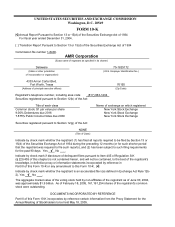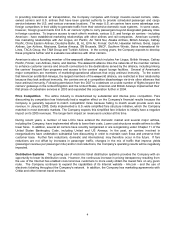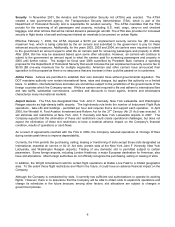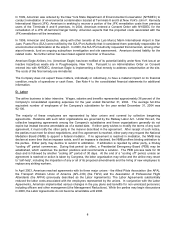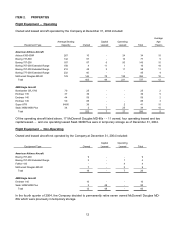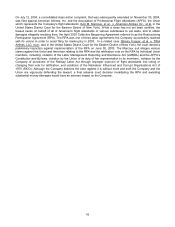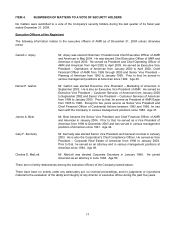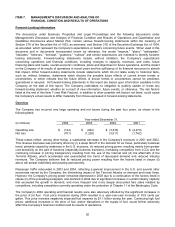American Airlines 2004 Annual Report Download - page 13
Download and view the complete annual report
Please find page 13 of the 2004 American Airlines annual report below. You can navigate through the pages in the report by either clicking on the pages listed below, or by using the keyword search tool below to find specific information within the annual report.
10
Additional information regarding the Company’s fuel program is also included in Item 7(A) – Quantitative and
Qualitative Disclosures about Market Risk and in Note 7 to the consolidated financial statements.
F. Frequent Flyer Program
American established the AAdvantage frequent flyer program (AAdvantage) to develop passenger loyalty by
offering awards to travelers for their continued patronage. The Company believes that the AAdvantage program is
one of its competitive strengths. AAdvantage members earn mileage credits for flights on American, American
Eagle and certain other participating airlines, or by using services of other program participants, including bank
credit card issuers, hotels, car rental companies and phone service companies. American sells mileage credits
and related services to the other companies participating in the program. American reserves the right to change
the AAdvantage program at any time without notice and may end the program with six months notice.
Mileage credits can be redeemed for free, discounted or upgraded travel on American, American Eagle or other
participating airlines, or for other travel industry awards. Once a member accrues sufficient mileage for an award,
the member may book award travel. Most travel awards are subject to capacity controlled seating. Mileage credit
does not expire, provided a customer has any type of qualifying activity at least once every 36 months. See Critical
Accounting Policies and Estimates under Item 7 for more information on AAdvantage.
G. Other Matters
Seasonality and Other Factors The Company’s results of operations for any interim period are not necessarily
indicative of those for the entire year, since the air transportation business is subject to seasonal fluctuations.
Higher demand for air travel has traditionally resulted in more favorable operating and financial results for the
second and third quarters of the year than for the first and fourth quarters. Fears of terrorism or war, fare initiatives,
fluctuations in fuel prices, labor actions, weather and other factors could impact this seasonal pattern. Unaudited
quarterly financial data for the two-year period ended December 31, 2004 is included in Note 15 to the
consolidated financial statements. In addition, the results of operations in the air transportation business have also
significantly fluctuated in the past in response to general economic conditions.
No material part of the business of AMR and its subsidiaries is dependent upon a single customer or very few
customers. Consequently, the loss of the Company's largest few customers would not have a materially adverse
effect upon the Company.
Insurance The Company carries insurance for public liability, passenger liability, property damage and all-risk
coverage for damage to its aircraft.
As a result of the Terrorist Attacks, aviation insurers significantly reduced the amount of insurance coverage
available to commercial air carriers for liability to persons other than employees or passengers for claims resulting
from acts of terrorism, war or similar events (war-risk coverage). At the same time, these insurers significantly
increased the premiums for aviation insurance in general.
The U.S. government has agreed to provide commercial war-risk insurance for U.S. based airlines until August 31,
2005 covering losses to employees, passengers, third parties and aircraft. In addition, the Secretary of
Transportation may extend the policy until December 31, 2005, at his discretion. However, there is no assurance
that it will be extended. If the U.S. government does not extend the policy beyond August 31, 2005, the Company
will attempt to purchase similar coverage with narrower scope from commercial insurers at an additional cost. To
the extent this coverage is not available at commercially reasonable rates, the Company’s results of operations
would be negatively affected. While the price of commercial insurance has declined in recent years, in the event
commercial insurance carriers further reduce the amount of insurance coverage available to the Company, or
significantly increase its cost, the Company’s operations and/or financial position and results of operations would
be adversely affected.


